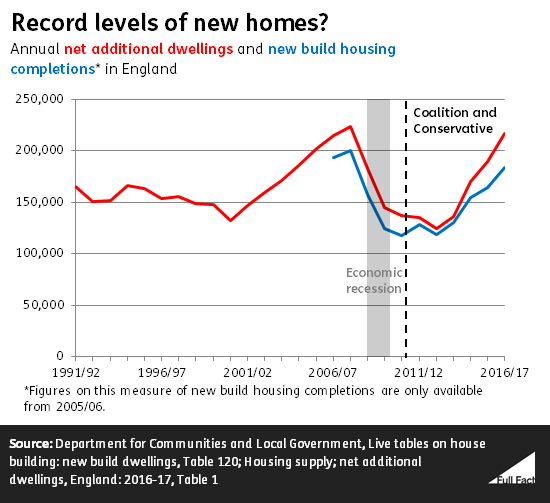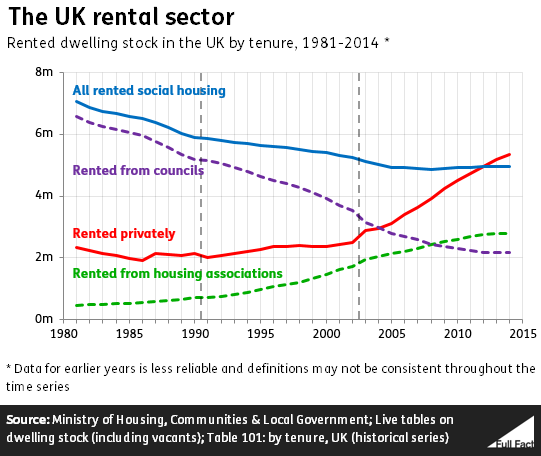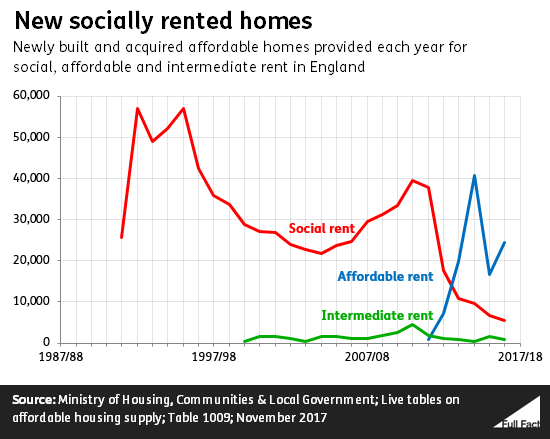BBC Question Time: factchecked
Question Time was in Westminster this week. The panelists were: Secretary of State for International Trade Liam Fox MP, Shadow Minister for Labour Laura Pidcock MP, Great British Bake Off judge Prue Leith, engineer and diversity campaigner Roma Agrawal and spoken word artists George the Poet. We looked at claims on: house building, the social housing sector, the steel industry and women in engineering.
There are 1.1 million more homes in England since 2010
“And the good news is that last year, 2017, we built more homes, 1.1 million, than in all but one of the last 30 years.”
Liam Fox, 8 March 2018
1.1 million homes have added to the overall stock of housing in England between April 2010 and March 2017. That’s not the same as homes built—it also includes buildings converted to homes for example, and also factors in buildings that have been demolished.
Talking specifically about new homes built, there have been 997,000 new homes built since then.
The Conservatives first entered government in coalition with the Liberal Democrats following the May 2010 election, but the houses completed during their first several months in office would have been started while the previous Labour government was in office. These were mainly built by a combination of housing associations, councils and the private sector.
Looking just at the most recent year, 2016/17, there were 217,000 homes added to the overall stock, including 184,000 new homes built.
217,000 new homes in the space of a year is the second highest on record over the last 26 years—which is as far back as the data goes. The highest on record was 224,000 in 2007/08. We’ve written more about that here.

The Ministry of Housing, Communities and Local Government publishes other figures that go further back, but, these are known to undercount the number of homes.
32,000 people work in the British steel industry
“An industry [the steel industry] that has already been decimated over many years. [...] You know, there’s 32,000 people’s jobs at risk.”
Laura Pidcock MP, 8 March 2018
There were 32,000 people employed in the steel industry in Great Britain in 2016. Over half of these jobs are concentrated in Wales, and Yorkshire and the Humber.
Using a narrower definition of the steel industry, which excludes those who work in steel processing, the number of people employed in it has fallen from 320,000 in 1971 to 24,000 in 2016. That’s according to to analysis by the House of Commons Library.
Ms Pidcock’s office told us she was referring to the situation in her North West Durham constituency when she talked about the industry being decimated. Consett, the major town in the constituency, had a steel works with 6,000 employees at its height in the 1960s. 4,000 jobs were lost when it closed in 1980, according to Co-Curate, a community based archive about North East England.
The House of Commons Library lists a number of reasons why the industry as a whole has been declining, including:
- Fewer people are needed to produce the same amount of steel today compared to 1970.
- Other countries now dominate the international steel market (China produced 50% of global steel in 2016, compared to 13% in 1995). Lower labour costs and other overheads mean they can produce steel more cheaply than the UK.
- A lot of jobs in the modern steel industry attract higher salaries and require higher skill levels, but require fewer people overall.
- The rise of the service sector, which accounts for 84% of UK employees.
Are further jobs at risk?
Ms Pidcock’s office told us that UK steel jobs are at risk from increasing tariffs outside the EU or a Customs Union. The Labour Party this week also expressed concern to the government about the the USA signing off 25% tariffs on its steel imports.
Currently, there are no tariffs on exporting British steel to the rest of the EU, as the UK is a member of the Customs Union.
After Brexit, we don’t yet know what tariffs UK companies might face when exporting steel, and this will partly depend on any trade deal the UK negotiates with the EU.
Theresa May has said we will be leaving the Customs Union, which creates tariff-free trade between EU member states and three other countries and sets a common tariff for countries outside. The EU also has trade agreements designed to facilitate trade with a number of other countries, which the UK will no longer be a part of after Brexit.
Under EU State Aid rules, the UK cannot normally use public funds to provide financial assistance to failing companies, as it distorts competition in the EU. Depending on the trade deal negotiated with the EU after Brexit, State Aid rules may no longer apply, in which case the government would have a greater ability to intervene in the steel market if it wished, according to the House of Commons Library.
11% of UK engineers are women
“I am one of less than 10% of female engineers in this country.”
Roma Agrawal, 8 March 2018
Slightly more than 10% of engineers are women, according to the latest data.
In April-June 2017, there were an estimated 48,000 women working in engineering professions in the UK, according to the the latest official figures. This is around 11% of the total. They estimated that there were just over 400,000 male engineers.
Because of the low numbers involved, the Office for National Statistics cautions against comparing these numbers over time. But, in the same period of 2011 women made up 6% of engineers, so it’s very likely the number has been on the rise.
Social housing stock has fallen over the last 30 years
“I think it’s important to note that we’ve stripped away over the past 30 years so much social housing, which has now been placed into the private rental market.”
BBC Question Time audience member, 8 March 2018
The size of the social housing sector has been decreasing over time.
The proportion of the population living in social housing in Great Britain halved between the early 1980s and early 2010s, according to the Institute for Fiscal Studies. The IFS puts this down to two key developments: the introduction of Right to Buy in 1980, which gave tenants the ability to buy their council houses at below market rates, and a general drop in the amount of social housing being built.
The number of homes for rent from councils or housing associations in the UK has been decreasing from a peak of around seven million in the early 1980s to just under five million in 2014.
In contrast the number of homes available for private rental has increased from around two million to over five million.
Social housing usually refers to homes rented at sub-market levels by councils and housing associations. “Social rent” levels are around 50% of market levels. The government also includes “affordable rent” homes in its definition of social housing, these are up to 80% of market levels.
There were around 5,000 homes for social rent built or acquired in England in 2016/17 compared to 24,000 for affordable rent.
Affordable rent properties were first introduced in 2011 and since then their number has increased significantly while the number of social rent properties has decreased.
We’ve written more about how affordable housing is, and house building in England more generally elsewhere.

